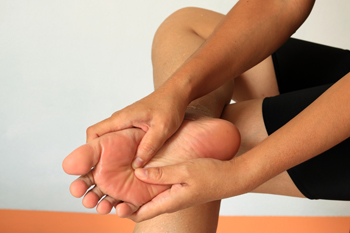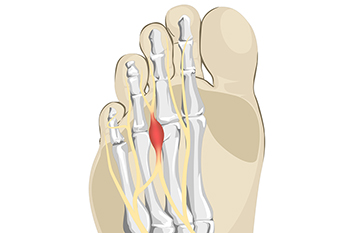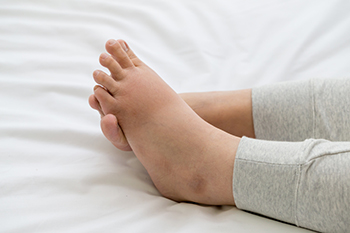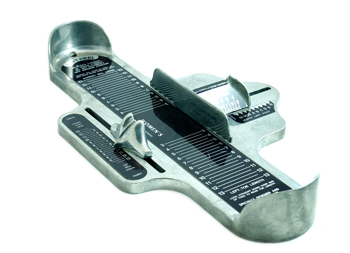Items filtered by date: January 2024
Surgery Considerations for Plantar Fibroma

Plantar fibroma, a benign yet often painful growth on the sole of the foot, presents challenges that prompt a range of treatment options. Non-surgical approaches typically involve conservative methods, such as orthotics and corticosteroid injections, to alleviate symptoms and reduce inflammation. However, in cases where the fibroma causes persistent discomfort or interferes with daily activities, surgical intervention may be considered. Surgery for plantar fibroma aims at excising the fibrous tissue and restoring optimal foot function. The procedure involves careful consideration of the fibroma's size, location, and impact on surrounding structures. Recovery from surgery may involve a period of immobilization to regain strength and flexibility. While surgical intervention poses inherent risks, it can offer significant relief and improved mobility for individuals grappling with the challenges posed by a plantar fibroma. If you have developed a plantar fibroma, it is suggested that you consult with a podiatrist who can determine if surgery is a correct treatment option for you.
A plantar fibroma may disrupt your daily activities. If you have any concerns, contact Kenneth Williams, DPM of Texas. Our doctor can provide the care you need to keep you pain-free and on your feet.
Plantar Fibroma
A plantar fibroma is a fibrous knot in the arch of the foot. It is embedded in the plantar fascia which is a band of tissue that extends from the heel to the toes along the bottom of the foot. There can be multiple plantar fibromas in the feet at the same time. There are no known causes for this condition. If you have a plantar fibroma, there will be a bump in the arch of your foot that cannot be missed. Any associated pain is most often due to a shoe rubbing against the nodule. Non-surgical options, such as steroid injections, physical therapy, and orthotics should be tried first. Surgery is a last resort and is the only thing that will remove a plantar fibroma entirely. Consult with a podiatrist for a proper diagnosis and to determine the treatment regimen that is right for you.
What Causes a Plantar Fibroma?
While there are no specific causes identified, a plantar fibroma can possibly come from genetic predisposition or the formation of scar tissue that forms from healing the tears in the plantar fascia.
What Are the Symptoms of a Plantar Fibroma?
There will be a noticeable lump in the arch of the foot that may or may not cause pain. If pain is felt, it is typically because a shoe is rubbing up against the lump or when walking or standing barefoot.
Treatment and Prevention
A plantar fibroma will not disappear without treatment, but it can get smaller and be a non-issue. If pain persists, a podiatrist examines the foot and when the arch of the foot is pressed, pain can be felt down to the toes. An MRI or biopsy might be performed to help diagnose or evaluate the plantar fibroma. The following non-surgical options are generally enough to reduce the size and pain of these nodules:
- Steroid injections
- Orthotics
- Physical therapy to help apply anti-inflammatory creams on the bump
Surgery is considered if the mass increases in size and the patient continues to feel pain after non-surgical methods are tried.
If you have any questions please feel free to contact our office located in San Antonio and Beeville, TX . We offer the newest diagnostic tools and technology to treat your foot and ankle needs.
Injury From a Winter Sport? Get the Care You Need
Managing a Broken Toe

Managing a broken toe can be a painful experience. A broken toe often results from accidentally stubbing it or dropping a heavy object on it. The toes, composed of two or three tiny bones, can incur fractures when subjected to such incidents. Symptoms of a broken toe can include pain, swelling, and potential discoloration of the toenail due to trapped blood. In the event of a toe fracture, a podiatrist typically treats it by buddy taping, where the broken toe is taped to the adjacent one for added support during the healing process. Additionally, wearing comfortable and roomy shoes is recommended to alleviate pressure on the injured toe. If blood is trapped under the toenail, a podiatrist may make a small hole to drain it and ease discomfort. It is important to note that broken toes rarely require realignment, and with proper care, including buddy taping and wearing appropriate footwear, a steady recovery is generally expected. If you suspect a broken toe, it is suggested that you schedule an appointment with a podiatrist for a treatment plan specific to the severity of your injury.
Broken toes may cause a lot of pain and should be treated as soon as possible. If you have any concerns about your feet, contact Kenneth Williams, DPM from Texas. Our doctor will treat your foot and ankle needs.
What Is a Broken Toe?
A broken toe occurs when one or more of the toe bones of the foot are broken after an injury. Injuries such as stubbing your toe or dropping a heavy object on it may cause a toe fracture.
Symptoms of a Broken Toe
- Swelling
- Pain (with/without wearing shoes)
- Stiffness
- Nail Injury
Although the injured toe should be monitored daily, it is especially important to have a podiatrist look at your toe if you have severe symptoms. Some of these symptoms include worsening or new pain that is not relieved with medication, sores, redness, or open wounds near the toe.
If you have any questions, please feel free to contact our office located in San Antonio and Beeville, TX . We offer the newest diagnostic and treatment technologies for all your foot care needs.
Utilizing Imaging Tests for Diagnosis and Treatment of Morton’s Neuroma

Morton's neuroma is a painful condition that affects the nerves in the ball of the foot, often causing discomfort and a sensation of a lump between the toes. To diagnose and effectively treat Morton's neuroma, podiatrists often employ various imaging tests. Ultrasound is a commonly used imaging technique to visualize Morton's neuroma. It provides real time images and allows for dynamic assessment, which can help in confirming the diagnosis. Ultrasound can also guide injections for therapeutic purposes. Magnetic resonance imaging, or MRI, is another valuable tool for evaluating Morton's neuroma. It offers detailed images of the foot's soft tissues, providing insight into the size and location of the neuroma. This can assist in treatment planning and determining the severity of the condition. X-rays, although less effective in directly visualizing neuromas, are sometimes used to rule out other foot conditions like bone abnormalities or arthritis. These imaging tests play a vital role in diagnosing Morton's neuroma and determining the most appropriate treatment approach, which may include conservative measures, injections, or surgical intervention. If you have pain in the ball of your foot, it is suggested that you schedule an appointment with a podiatrist, as early intervention can lead to more effective management of this painful foot condition.
Morton’s neuroma is a very uncomfortable condition to live with. If you think you have Morton’s neuroma, contact Kenneth Williams, DPM of Texas. Our doctor will attend to all of your foot care needs and answer any of your related questions.
Morton’s Neuroma
Morton's neuroma is a painful foot condition that commonly affects the areas between the second and third or third and fourth toe, although other areas of the foot are also susceptible. Morton’s neuroma is caused by an inflamed nerve in the foot that is being squeezed and aggravated by surrounding bones.
What Increases the Chances of Having Morton’s Neuroma?
- Ill-fitting high heels or shoes that add pressure to the toe or foot
- Jogging, running or any sport that involves constant impact to the foot
- Flat feet, bunions, and any other foot deformities
Morton’s neuroma is a very treatable condition. Orthotics and shoe inserts can often be used to alleviate the pain on the forefront of the feet. In more severe cases, corticosteroids can also be prescribed. In order to figure out the best treatment for your neuroma, it’s recommended to seek the care of a podiatrist who can diagnose your condition and provide different treatment options.
If you have any questions, please feel free to contact our office located in San Antonio and Beeville, TX . We offer the newest diagnostic and treatment technologies for all your foot care needs.
Foot and Leg Problems During Pregnancy

During pregnancy, it is common to experience changes in the feet, which may include foot cramps, swelling, more noticeable veins, and toenail problems. Self-care, including resting frequently, stretching, staying hydrated, and wearing well-fitting shoes may help most foot and leg issues during pregnancy. While these conditions are generally not serious, it is essential to recognize that some changes in the legs and feet could signal pregnancy complications, such as preeclampsia, which require immediate medical attention. Pregnancy leads to hormonal fluctuations that relax ligaments and prepare the body for childbirth, affecting various parts, including the feet. This hormonal influence can result in flat feet, overpronation, and an increase in shoe size. The additional weight from the growing uterus, fetus, and breasts can place added stress on the feet, often causing heel pain like plantar fasciitis due to the strain on the arches. Changes in the center of gravity and posture can also impact balance. To manage foot and heel discomfort during pregnancy, it is suggested that you schedule an appointment with a podiatrist who can properly address any foot or ankle problems you may encounter.
Pregnant women with swollen feet can be treated with a variety of different methods that are readily available. For more information about other cures for swollen feet during pregnancy, consult with Kenneth Williams, DPM from Texas. Our doctor will attend to all of your foot and ankle needs.
What Foot Problems Can Arise During Pregnancy?
One problem that can occur is overpronation, which occurs when the arch of the foot flattens and tends to roll inward. This can cause pain and discomfort in your heels while you’re walking or even just standing up, trying to support your baby.
Another problem is edema, or swelling in the extremities. This often affects the feet during pregnancy but tends to occur in the later stages.
How Can I Keep My Feet Healthy During Pregnancy?
- Wearing orthotics can provide extra support for the feet and help distribute weight evenly
- Minimize the amount of time spent walking barefoot
- Wear shoes with good arch support
- Wear shoes that allow for good circulation to the feet
- Elevate feet if you experience swelling
- Massage your feet
- Get regular, light exercise, such as walking, to promote blood circulation to the feet
If you have any questions please feel free to contact our office located in San Antonio and Beeville, TX . We offer the newest diagnostic and treatment technologies for all your foot and ankle needs.
Using the Brannock Device for Proper Shoe Fitting

Fitting shoes properly is an important aspect of foot health and overall comfort. The Brannock device, a ubiquitous foot-measuring tool found in shoe stores, is a valuable tool for ensuring the right fit. Using the Brannock device is a straightforward process. Start by removing your current footwear and placing one foot onto the device's base, ensuring your heel is snug against the heel cup. Then, adjust the slider to reach the tip of your longest toe, typically the big toe. The device provides three key measurements, which are the heel-to-toe length, arch length, and width. Pay attention to all three as they contribute to a well-fitted shoe. The Brannock device takes the guesswork out of shoe sizing, enabling you to find the ideal fit. Remember that feet can vary in size, and it is essential to measure both feet. When trying on shoes, use the larger foot's measurements as a guide for the best overall fit. Properly fitted shoes can prevent discomfort, reduce the risk of foot problems, and provide a foundation for healthy, happy feet. A podiatrist can assist you in how to use the Brannock device to obtain your proper shoe size, and it is suggested that you confer with this type of doctor for any questions you may have.
Finding a properly-fitting shoe is important in reducing injuries and preventing foot problems. For more information about treatment, contact Kenneth Williams, DPM from Texas. Our doctor will treat your foot and ankle needs.
Proper Shoe Fitting
A common concern when it comes to foot health, having properly fitted shoes can help prevent injuries to the foot. Out feet affect our posture and gait, which in turn affects the biomechanics and overall bodily structure. With 33 joints, 26 bones, and over 100 ligaments, the potential for serious injury is much greater than one realizes. Although the feet cease growth in adulthood, they still change shape as they mature. Here are some factors to consider when it comes to investing in proper fitting shoes:
- Be sure the shoes fit correctly right away
- Ensure the ball of your foot fits comfortably in the widest portion of the shoes
- Even though they may look fashionable, improper fitting shoes can either create adverse conditions or exacerbate existing ones you may already have
- Walk along a carpeted surface to ensure the shoes comfortably fit during normal activity
Keeping in mind how shoes fit the biomechanics of your body, properly-fitting shoes are vitally important. Fortunately, it is not difficult to acquire footwear that fits correctly. Be sure to wear shoes that support the overall structure of your body. Do your feet a favor and invest in several pairs of well-fitted shoes today.
If you have any questions, please feel free to contact our office located in San Antonio and Beeville, TX . We offer the newest diagnostic and treatment technologies for all your foot care needs.

